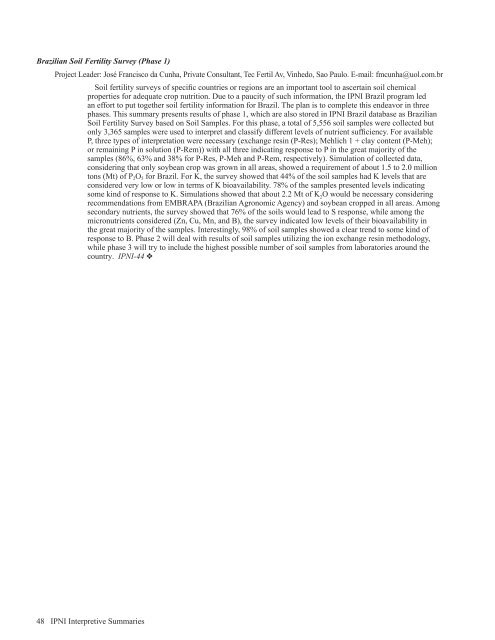Americas and Oceania Group - International Plant Nutrition Institute
Americas and Oceania Group - International Plant Nutrition Institute
Americas and Oceania Group - International Plant Nutrition Institute
You also want an ePaper? Increase the reach of your titles
YUMPU automatically turns print PDFs into web optimized ePapers that Google loves.
Brazilian Soil Fertility Survey (Phase 1)<br />
Project Leader: José Francisco da Cunha, Private Consultant, Tec Fertil Av, Vinhedo, Sao Paulo. E-mail: fmcunha@uol.com.br<br />
Soil fertility surveys of specific countries or regions are an important tool to ascertain soil chemical<br />
properties for adequate crop nutrition. Due to a paucity of such information, the IPNI Brazil program led<br />
an effort to put together soil fertility information for Brazil. The plan is to complete this endeavor in three<br />
phases. This summary presents results of phase 1, which are also stored in IPNI Brazil database as Brazilian<br />
Soil Fertility Survey based on Soil Samples. For this phase, a total of 5,556 soil samples were collected but<br />
only 3,365 samples were used to interpret <strong>and</strong> classify different levels of nutrient sufficiency. For available<br />
P, three types of interpretation were necessary (exchange resin (P-Res); Mehlich 1 + clay content (P-Meh);<br />
or remaining P in solution (P-Rem)) with all three indicating response to P in the great majority of the<br />
samples (86%, 63% <strong>and</strong> 38% for P-Res, P-Meh <strong>and</strong> P-Rem, respectively). Simulation of collected data,<br />
considering that only soybean crop was grown in all areas, showed a requirement of about 1.5 to 2.0 million<br />
tons (Mt) of P 2 O 5 for Brazil. For K, the survey showed that 44% of the soil samples had K levels that are<br />
considered very low or low in terms of K bioavailability. 78% of the samples presented levels indicating<br />
some kind of response to K. Simulations showed that about 2.2 Mt of K 2 O would be necessary considering<br />
recommendations from EMBRAPA (Brazilian Agronomic Agency) <strong>and</strong> soybean cropped in all areas. Among<br />
secondary nutrients, the survey showed that 76% of the soils would lead to S response, while among the<br />
micronutrients considered (Zn, Cu, Mn, <strong>and</strong> B), the survey indicated low levels of their bioavailability in<br />
the great majority of the samples. Interestingly, 98% of soil samples showed a clear trend to some kind of<br />
response to B. Phase 2 will deal with results of soil samples utilizing the ion exchange resin methodology,<br />
while phase 3 will try to include the highest possible number of soil samples from laboratories around the<br />
country. IPNI-44 v<br />
48 IPNI Interpretive Summaries

















